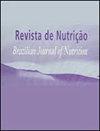住院病人能否充分估计自己的食物摄入量?横断面试点研究
IF 0.5
4区 医学
Q4 NUTRITION & DIETETICS
Revista De Nutricao-brazilian Journal of Nutrition
Pub Date : 2022-01-01
DOI:10.1590/1678-9865202235e210168
引用次数: 0
摘要
【摘要】目的通过患者填写的自我监测量表,评估和识别影响患者摄食量估算准确性的因素。方法采用横断面研究方法对常规饮食或治疗性饮食的住院成人患者进行研究。实际食物摄入量百分比由实际食物摄入量与提供的食物量之比× 100得到。患者必须完成一份食物表,包括9个圆圈,以百分比表示盘子中的食物(增加12.5%的比例),以代表他们在午餐和/或晚餐时的食物摄入量。Bland-Altman方法评估了实际值和估计值之间的一致性。变量(年龄、性别、住院天数、饮食处方、食物供应量和实际食物摄入百分比)与食物摄入估计的准确性(充足±10%、高估和低估)之间的相关性通过单变量多项logistic回归进行评估。结果96例患者接受评估,其中男性51.0%;(44.0±15.8岁)。Bland-Altman的分析表明,实际的食物摄入量和估计的食物摄入量非常吻合。实际食物摄入百分比是唯一与食物摄入估计准确性相关的变量。结论绝大多数(约70%)的患者使用9点食物表对自己的食物摄入量进行了充分的估计。此外,与食物摄入估计的准确性有关的唯一因素是实际的食物摄入百分比。这些发现为该工具的有用性提供了初步支持。然而,它必须在住院患者的代表性样本中进行测试。本文章由计算机程序翻译,如有差异,请以英文原文为准。
Can hospitalized patients adequately estimate their own food intake? A cross-sectional pilot study
ABSTRACT Objective To assess and identify factors linked to the accuracy of patients’ food intake estimations through a self-monitoring instrument filled in by the patient. Methods This cross-sectional study approached adult hospital patients subjected to regular or therapeutic diets. The actual food intake percentage was obtained by the ratio between the actual food intake and the amount of food served x 100. Patients had to complete a food chart including 9 circles representing plates of food in percentages (increasing scale of 12.5%) to represent their food intake at lunch and/or dinner. The Bland-Altman method assessed the agreement between the actual and the estimated values. The associations between variables (age, sex, hospitalization day, diet prescription, amount of food served and actual food intake percentage) and the accuracy of the food intake estimation (adequate ±10%, overestimated and underestimated) were evaluated through univariate multinomial logistic regression. Results Ninety-six patients were evaluated (51.0% male; 44.0±15.8 years of age). The Bland-Altman analysis showed good agreement between the actual and the estimated food intake. The actual food intake percentage was the only variable associated with the accuracy of the food intake estimation. Conclusion Most patients (~70%) adequately estimated their food intake using the 9-point food chart tested. Furthermore, the only factor linked to the accuracy of the food intake estimation was the actual food-intake percentage. These findings provide preliminary support for the usefulness of this instrument. However, it must be tested in a representative sample of hospitalized patients.
求助全文
通过发布文献求助,成功后即可免费获取论文全文。
去求助
来源期刊
CiteScore
1.20
自引率
12.50%
发文量
24
审稿时长
6-12 weeks
期刊介绍:
Revista de Nutrição is former Revista de Nutrição da Puccamp, founded in 1988. It is a bimonthly publication every four months and it is of responsibility of the Centro de Ciências da Vida, da Pontifícia Universidade Católica de Campinas . It publishes articles that contribute to the study of Nutrition in its many sub-areas and interfaces; and is open to contributions of the national and international scientific communities.

 求助内容:
求助内容: 应助结果提醒方式:
应助结果提醒方式:


